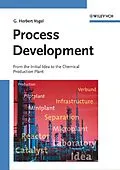Von der Ideenfindung zur chemischen Produktionsanlage ist es ein weiter Weg. Kaum etwas ist so komplex wie die Herstellung chemischer Produkte.
Die verschiedensten Aspekte - auch solche, die in der Ausbildung von Naturwissenschaftlern vielleicht nur am Rande oder gar nicht berücksichtigt werden wie etwa Wirtschaftlichkeitsbetrachtungen, die Patent- und Lizenzsituation, Anforderungen an den Standort, Entsorgungsprobleme - werden dargestellt.
Das Buch eignet sich für den Berufsanfänger ebenso wie für den Praktiker im Betrieb. Es ist eine gemeinsame Grundlage für Ingenieure und Chemiker und sollte als Nachschlagewerk auf keinem Schreibtisch fehlen.
Der Autor beschränkt sich nicht auf Verweise auf weiterführende Literatur: viele Fakten werden wiederholt und in Zusammenhang zum Thema gebracht, Formeln kurz abgeleitet, so dass sich der Gang in die Bibliothek und der Griff zu weiteren Büchern häufig erübrigt. Es hilft Mitarbeitern in Forschung und Entwicklung ebenso wie Betriebsleitern, Fehler zu vermeiden und vermittelt die nötige Sicherheit.
Autorentext
Born in 1951 near Gross-Gerau, Germany, G. Herbert Vogel served an apprenticeship at Rohm & Haas before going on to study chemical engineering at Darmstadt Polytechnic and chemistry at Darmstadt Technical University, where he obtained his doctorate in 1982 in physical chemistry under Alarich Weiss. Between 1982 and 1993 he was employed at BASF AG in Ludwigshafen, working on the development, planning, construction and installation of petrochemical production plants. In 1993, he succeeded Fritz Fetting as Professor for Chemical Engineering at Darmstadt TU. His research interests are heterogeneous catalysis, chemistry under supercritical conditions and renewable primary products.
Klappentext
There is a long way to go between the original idea and the final chemical production plant. Almost nothing else is as complex as the manufacture of chemical products.
This book presents all the different aspects, including those that are maybe only touched upon or not even covered at all as part of a course in natural sciences, such as economic factors, patents and licensing, site requirements and problems of waste disposal.
Nor does the author limit himself to mere references to further reading: many of the facts are reiterated and placed in the relevant context, while formulas are briefly derived, often saving a walk to the library or searching in other texts. He thus helps those working in R&D as well as plant managers to avoid pitfalls, while also conveying the required degree of safety.
The result is a volume equally suited for those entering the sector as well as for scientists already working at a plant. It forms a common basis for engineers and chemists, representing a ready reference that should always be within arm's reach.
Zusammenfassung
Guiding readers through all steps of the complex process, this book covers the most diverse aspects of chemicals production, including those not or insufficiently covered in natural science courses. These comprise economic feasibility, patenting and licensing, demands on the location and the problem of waste disposal.
Throughout, the author does not rely on simple references to other literature but instead reiterates many facts and places them in context, as well as succinctly explaining formulas, thus removing the need to look up items in secondary reference works.
As such, the book is suitable for both newcomers as well as those already working in the field. Those working in R&D as well as plant managers will learn how to avoid pitfalls, resulting in higher safety. A common basis and indispensable ready reference for engineers and chemists.
Inhalt
EINFÜHRUNG
Das Ziel industrieller Forschung und Entwicklung
Die Produktionsstruktur der chemischen Industrie
Aufgaben der Verfahrensentwicklung
Ideenfindung, Selektion und Prüfung
DIE GESAMTANLAGE UND IHRE BESTANDTEILE
Katalysator
Reaktor
Thermische und Mechanische Trennverfahren
Rohrleitungssystem, Pumpen, Kompressoren
Energieversorgung
Produktversorgung und Lagerung
Rückstandsentsorgung
Mess-, Steuerungs- und Regeltechnik
Anlagensicherheit
Werkstoffauswahl
VERFAHRENSUNTERLAGEN
Chemische Daten
Massenbilanz
Aufarbeitung
Patent- und Lizenzsituation
Entwicklungskosten
Standort
Marktsituation
Rohstoffe
Anlagenkapazität
Entsorgungssituation
Endprodukt
ABLAUF EINER VERFAHRENSENTWICKLUNG
Verfahrensentwicklung als iterativer Prozess
Aufstellung eines Verfahrenskonzeptes
Prüfung der Einzelschritte
Mikroplant, Schnittstelle zwischen Labor und Technikum
Prüfung des Gesamtverfahrens im Technikum
PLANUNG, ERRICHTUNG UND BETRIEB CHEMISCHER ANLAGEN
Allgemeiner Ablauf einer Projektabwicklung
Wichtige Teilaspekte bei der Projektabwicklung
Commissioning
Inbetriebnahme
VERFAHRENSBERWERTUNG
Erstellen von Studien
Rentabilität
Wirtschaftliches Risiko
TRENDS IN DER VERFAHRENSENTWICKLUNG
Anhang
